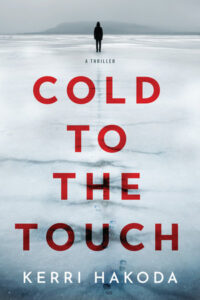From the time gold was discovered here in 1871, Alaska has been a magnet for a certain type of risk-taker. Daredevil fortune seekers came, seduced by the area’s seemingly infinite riches – miners, traders, trappers, and crab fishermen all answering Alaska’s siren song.
Throughout Alaska’s recorded history, yet another kind of risk-taker has gravitated to The Last Frontier. Lured by the vastness of the terrain, its Wild West lawlessness, its endless winter nights, or all of the above – serial killers have left their mark.
I set my debut mystery/thriller Cold To The Touch in this locale because of its unique, stark beauty and its ability to harbor the darkest and most sinister of predators.
Edward Krause, Alaska’s first known serial killer, is said to be responsible for the deaths of at least ten men between 1912 and 1915, killing them for their real estate holdings and bank balances. His true identity was Edward Klompke, a U.S. Army deserter. He was sentenced to hang but escaped two days before his execution. He met his end when a homesteader shot and killed him for a $1000 reward.
Klutuk, “The Mad Trapper of Bristol Bay,” was a Yupi’k trapper named for a small tributary of the Nushagak River in Western Alaska. Between 1919 and 1931, he stalked trappers and prospectors in the wilderness between Cook Inlet and the Kuskokwim River. Fiercely territorial, he supposedly killed twenty or more men he perceived as infringing on his domain. After an exhaustive manhunt that covered several thousand square miles, a U.S. Marshal found remains he claimed to be Klutuk in a cabin near the Mulchatna River.
Harvey Carignan killed 58-year-old Laura Showalter in the Territory of Alaska in 1949, while stationed in the U.S. Army in Anchorage. Although Showalter was his only Alaska victim, Carignan also killed two young women in Washington – one who answered a “help wanted” ad he posted for his gas station – and two women in Minnesota. He died in prison in Minnesota.
Thomas Richard Bunday was serving at Eielson Air Force Base near Fairbanks when he murdered five girls and young women between 1979 and 1981. With no physical evidence to hold him in Alaska, Bunday was able to transfer to Sheppard Air Force Base in Texas. He finally confessed in 1988, but killed himself before Alaskan detectives could apprehend him.
Joshua Alan Wade claimed to have killed his first victim on an Anchorage bike trail when he was fourteen. He went on to kill four more people, including his neighbor, a nurse practitioner. After forcing her to give up her ATM and PIN, he shot her in the head and burned her body. He is serving a life sentence in a federal prison in Indiana.
James Dale Ritchie started killing in 2016, when he shot a homeless woman and a male acquaintance. Twenty-six days later he shot a young man, presumably for his bicycle, which he rode away from the scene. A month later, he killed a homeless man and a young environmental activist out on a late-night bike ride. Ritchie himself was killed during a gunfight with Anchorage police.
Robert Christian Hansen was the most notorious of the Alaskan serial killers, called the “Butcher Baker” because he owned a bakery a short distance from Merrill Field, where he kept his plane. From 1971 to 1983, he abducted, raped and murdered at least seventeen Alaskan girls and women, many of whom were exotic dancers or sex workers. Some he flew out to a remote location in his Piper Super Cub and hunted them in the wilderness with a semi-automatic rifle.
When Hansen was apprehended, investigators found an aeronautical chart with thirty-seven “x” marks on it, leading officials to believe that he was responsible for far more deaths than he claimed. Hansen was only formally charged with the murders of four victims – of these, only “Eklutna Annie” has not yet been identified. He died of natural causes in 2014 while serving a life sentence.
Long-haul trucker John Joseph Fautenberry confessed to killing six people across five states, including Jefferson Diffee, a miner at the Greens Creek silver mine near Juneau. After pleading guilty to killing Diffee and given a 99-year prison term in Alaska, he was extradited to Ohio. Here he was sentenced to death for previously killing and robbing Joseph Daron, Jr., a Good Samaritan who had stopped to offer him a ride. Fautenberry was executed there by lethal injection in 2009.
Although Israel Keyes is believed to have committed multiple murders from 2001 to 2012, he has identified only three by name: William and Lorraine Currier of Essex, Vermont, and Samantha Koenig, a barista in Anchorage. In 2007, after living for six years on the Makah Reservation, Keyes left Washington state for Alaska where he started a contracting business. It was during one of his many trips to the Lower 48 that he meticulously stalked William and Lorraine Currier.
Two years prior to the killing of the Curriers, Keyes had buried near their home a five-gallon drum of guns, ammunition, a silencer, zip ties, and duct tape. Using the contents of this “murder kit”, he tortured and murdered the Curriers, a middle-aged couple he had never met before, and left them to rot in an abandoned farmhouse. The Curriers’ remains were never found.
Eighteen-year-old Samantha Koenig was a barista at Common Grounds coffee stand when Keyes abducted her at gunpoint on February 1, 2012. He took her to a shed just a few feet from his home where he sexually assaulted and killed her. Then he left on a two-week cruise in the Gulf of Mexico. When he returned, he applied makeup to Koenig’s face, sewed her eyes open with fishing line and photographed her with a four-day old issue of the Anchorage Daily News to make it appear she was still alive. He posted a ransom note demanding $30,000 in a local park, after which he dismembered Koenig’s body and disposed of it in Matanuska Lake, north of Anchorage. Officials tracked the use of the dead woman’s ATM card as Keyes moved across the southwestern United States. He was finally arrested in Texas and extradited to Alaska. He died by suicide on December 2, 2012.
Keyes was born in Utah to a Mormon family. Fautenberry was from Connecticut, Bunday from Tennessee, Hansen from Iowa. For these killers, Alaska was as far as they could go – literally and figuratively. Alaska encompasses 365 million acres – only 160,000 of which have been settled by humans. Only 1580 sworn law enforcement officers safeguard this landmass, twice the size of Texas (2024 World Population Review). Maybe these killers believed their unthinkable crimes would be undiscovered or unpunished in this sparsely policed wilderness.
Victims are lost here as well, never to be found, like so many of Hansen’s and Keyes’ casualties. Bodies decompose, undisturbed, in pristine lakes or are scattered by animals, strewn into the darkness of the long Alaska nights.
***


















